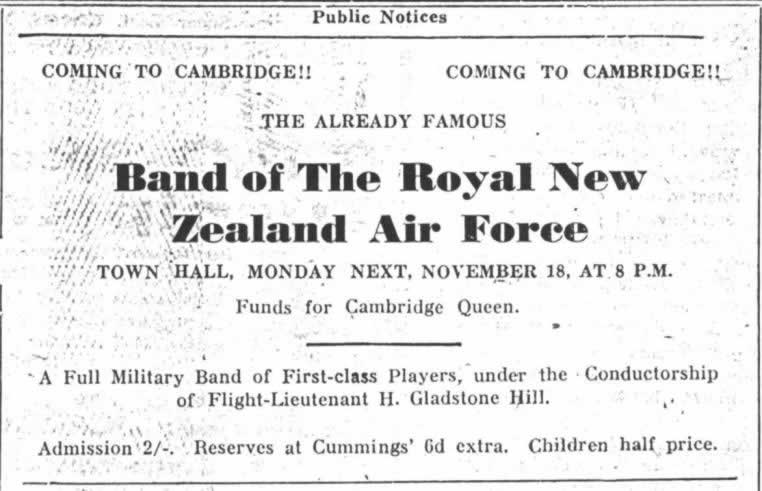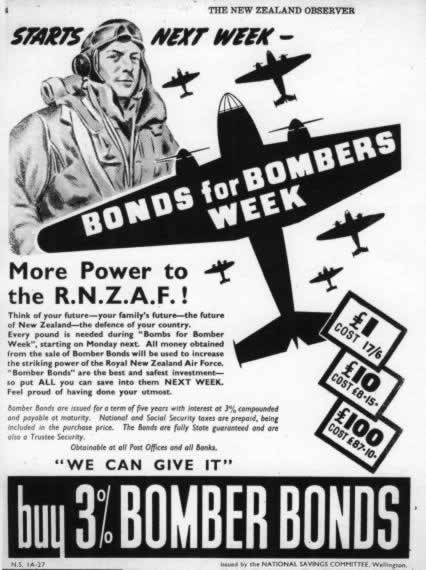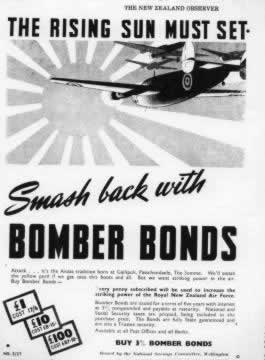MENU
August 1942 Visit
March 1944 Visit
The RNZAF Band in Cambridge
During the Second World War, Cambridge was treated to several visits by the outstanding Central Band of the Royal New Zealand Air Force. Formed in May 1935, the band made its public debut on the 12th of May 1937, just a month after the RNZAF became a stand-alone service. The band came into its own when war broke out. Its members were full time professionals, and under the leadership of Flight Lieutenant Gladstone Hill (a Hamilton man who was well-known in Cambridge before the war), they toured New Zealand 's cities, towns and provinces. Their music helped to raise morale of the people, but more importantly they usually tagged on some sort of drive with the band's tours to raise money for the war effort. Later in the war, the band went on to tour some of the Pacific bases to entertain the troops, and they also toured the USA.The band made several visits to Cambridge during the war, proving to be extremely popular with the locals. They raised the spirits of Cambridge people with concerts, dances and parades through town. Below are some details of the visits they made, and for quick reference use the menu on the left.
Note - all the quoted articles are written as they were printed originally, grammatical errors and all. It isn't my fault!!
The 1940 Visit
The RNZAF Band's First Visit to Cambridge
The advertisement that is reproduced above, appeared in the Waikato Independent newspaper on the 13th of November 1940. It was repeated again on the 15th. Also in the paper on the 13th was this article announcing the upcoming visit of the RNZAF Band.
AIR FORCE BAND
VISIT TO CAMBRIDGE
The band of the Royal New Zealand Air Force will visit Cambridge next Monday and provide an entertaining in the Town Hall, to aid the Cambridge Queen in the Patriotic Carnival. Of special interest to Cambridge is te fact that Bandsman T. Mowat, of Karapiro, is soprano cornet in the band.
A very successful tour of the South Island has just been completed by the band. It is reported to be a first-class and versatile combination. The conductor is Flight-Lieutenant H. Gladstone Hill, formerly of Hamilton, and well known in Cambridge.
Everywhere in the South Island the band made a deep impression, and was given enthusiastic receptions, both for its outdoor and and indoor performances, states a Southern report. The tour so far had done much to stimulate interest in the patriotic appeal.
Referring to some of the appearances made by the band in the south, it is said that at Oamaru people stood in the rain for an hour to listen to the programme, and for the concert given in the Dunedin Town Hall there was an audience of 2500.
The following notice appeared in the Waikato Independent newspaper dated the 15th of November 1940, announcing the upcoming visit of the RNZAF Band. This was to be the first visit of the Royal New Zealand Air Force Band to Cambridge, and would be so popular the band would return several times later.
AIR FORCE BAND
PROGRAMME ON MONDAY
The Royal New Zealand Air Force Band of 59 players will visit Cambridge on Monday to provide a concert in the Town Hall in the evening. The band, which is conducted by Flight-Lieutenant H. Gladstone Hill, was noted in the South Island for the varied and appealing programmes presented.
The members of the band will arrive by train on Monday morning. Arrangements are being made for them to parade in Victoria Street during the afternoon.
On the 20th of November, two days after the band's visit, the following review was published in the Waikato Independent.
AIR FORCE BAND
CONCERT IN CAMBRIDGE
A BRILLIANT PERFORMANCE
Not since the Australian Steel Works Band paid a visit 12 years ago, has Cambridge enjoyed such an excellent programme of Band music as that presented by the Royal New Zealand Air Force Band in the Town Hall on Monday evening. It was the first true military band to visit Cambridge, the combination consisting of reeds, windwood, and strings, as well as the usual brass instruments.
Under the direction of Flight-Lieutenant Gladstone Hill, the band of 58 players presented a varied programme, equal to the standard set by leading English bands. The items ranged from the works of the great masters to popular march tunes. The soloists of the band have been professional musicians and their work was outstanding.
The programme opened with a verse of "God Defend New Zealand," followed by Sousa's well-known march, "Stars and Stripes." A strong drum section added to the effectiveness of the band. On the stage were eight side-drummers, with white gauntlet gloves, and tympani and effects, handled by Sergeant T. Hardwick. The drummers were featured in the waltz, "Maori Melodies", giving a fine exhibition of precision work with the sticks. It was stated afterwards that this number is very attractive when played on parade as a slow march.
CONCERT NUMBERS
The drummers left the stage for the concert numbers, which included the first and fourth movements of "Ballet Egyptian" (Luigini); Schubert's famous "March Militaire"; and "Humoresque" (Dvorak); "Thoughts" (Alford). The full band played the march, "My Regiment" (Blankenburgh), and the patriotic number, "There'll Always Be An England," with Bandsman A. Stein as vocalist.
Further numbers by the band were an Eastern fantasia, "Babylon Nights" (J.S. Zamecrik); the sketch "Down South" (Myddleton); "The Sanctuary of the Heart," with vocal trio by Bandsmen A. Stein, A. McWhinnie and A. Barr; "Waiata Poi" (Alfred Hill) arranged for the band by Flight-Lieutenant Gladstone Hill; the march "Invercargill" (Lithgow).
Several of the bandsmen showed their versatility by playing more than one instrument. Bandsman M. Wishnowsky entertained with two piano-accordian solos, "Twelfth Street Rag" and "There's a Boy Coming Hone on Leave"; and Bandsman W.D. Boffa (flute), A. Munro (Violin), and K. Thurkettle (piano) played Titl's "Serenade" Bandsman Boffa is a flautist with exceptional ability.
One of the gems of the evening was a duet for flute and clarinet, "Lo, Here the Gentle Lark" (Bishop). The instrumentalists, Bandsmen W.D. Boffa and J. McCaw, blended their artistry beautifully, and the band added an effective accompaniment. Bandsman McCaw gave a fine performance of the difficult clarinet solo, "Les Alsachiennes" (Te Thiere).
From the cornet section, Bandsman H.W.C. Geard and J.G.T. Hookway gave a fine rendering of the duet "Ida and Dot" (Losey).
Sergeant T. Hardwick, who is the drum-major on parade, is an accomplished concert drummer. He gave a bright rendition of the xylophone solo "Sparks" (Alford); and Bandsman L. Carruthers played the trombone solo, "On With the Motley," from the opera "Il Pagliacci" (Leoncavallo)
Bandsman A. Barr is the possessor of a pleasing tenor voice and his singing of Schubert's "Serenade" demanded an encore. He responded with "The Rose of Tralee."
APPRECIATION EXPRESSED
During the evening, the Mayor, Mr Edgar James, thanked Flight-Lieutenant Hill for bringing such a wonderful band to Cambridge. He congratulated the conductor and the bandsmen on their efforts, and said he considered the combination was fit to travel the world. He hoped that after the war was over the band would travel overseas to show the musical talent that New Zealand possessed.
It was a fine gesture for the band to come to Cambridge to help the Queen Carnival funds, added Mr James. He said that he had decided to write to the Minister of Internal Affairs to tell him the great work that the band was doing on behalf of the Patriotic Committees.
Mr James thanked the residents of Cambridge who had billetted the bandsmen. It was typical of Cambridge that more offers had been received than needed.
Bonds For Bombers - The RNZAF Band's Second Visit
The second visit of the band occurred on Wednesday the 25th of March 1942. Their objectives were to entertain and to entice the locals to give generously towards the ‘Bonds For Bombers' scheme. These war bonds were a way to raise money for the RNZAF to buy new bomber aircraft. The money given to the Government was considered a loan with an extra 3% return when the war was over. Cambridge rallied to the cause.
In the weeks leading up to the band's visit, large front-page adverts and several articles publicised the event in several issues of the Waikato Independent newspaper. Because the band would begin its display in the afternoon on a Wednesday, Mayor Edgar James decreed that shops should be closed early to allow everyone to attend the performance, ensuring a good turn out. Local schools too were encouraged to allow children to attend the event.
The fundraising for the ‘Bonds For Bombers' campaign began on Monday the 23rd of March and ran till the following Friday. The highlight would of course be the visit by the band, but residents of Cambridge and the district were encouraged to give generously to the cause all week.
It wasn't just Cambridge involved in the scheme however, ‘Bonds For Bombers' week was running all over New Zealand, so having the RNZAF Band visiting was no doubt a bit of a coup, and it can be assumed that the band had a very busy week traveling the country.
The event seems to have gone very well indeed. The Waikato Independent gave a rousing description of the band's visit in the paper on the following Friday. The article stated, “… all the streets were thronged to witness the visit of the Royal New Zealand Air Force Band and planes added stimulus to the “Bonds For Bombers” Campaign, which is at present being conducted in Cambridge and throughout New Zealand.”
The article describes the afternoon in detail from its beginning, shortly after 2.00pm when all the shops had shut. A procession, “consisting of several army cars and armoured cars, the Royal Air Force Band, a detachment of troops, the WWSA, St John Ambulance Nursing Division and army trucks moved down Victoria Street from the Town Hall, along Duke Street, and back to the Town Hall, the whole then doing a circuit of Jubilee Park - the band, troops, WWSA and Nursing Division halting in front of the Town Hall, while the mechanised section continued up Victoria Street.”
To explain certain elements made in this statement, the band was of course in fact the RNZAF Band, not the RAF Band as the newspaper wrongly stated. The ‘detachment of troops' was most likely to be members of the NZ Territorials or perhaps even regular force Army troops who were in camp at the Cambridge Raceway in Taylor Street, as this was an Army training depot during the war. Alternately they may have been from the military camp at Hautapu, just north of Cambridge. The WWSA, or Woman's War Service Auxiliary was a volunteer organisation that aided in many patriotic efforts throughout the war. And Jubilee Park, for those Cambridge people who are unaware – as it is very rarely referred to by its proper name these days – is the piece of parkland that the Town Clock and Cenotaph stand on. Due to recent upgrades in the town, Jubilee Park actually butts right up to the front of the Town Hall, but during the war the two were separated by Kirkwood Street, so the park could be driven (and marched) right around like an island.
The paper continues the story, “Jubilee Park being triangular, enabled the procession, as it was moving round, at one period to form a huge V.” The paper's mention of this as seemingly having some significance no doubt relates to the "V for Victory” campaign that was prominent in the Allied countries at the time, lead by Winston Churchill, in which the letter ‘V' spurred on morale.
A highlight of the proceedings was a visit, “promptly at 2.30pm” of three RNZAF bombers in formation to make a flypast. The papers says they were “flying at low altitude, and made several circuits of the town before returning to their base.” Sadly the reporter gave no hint of what type the aircraft were, but at that time of the war if they were indeed real bombers, they would have to have been either Lockheed Hudsons or Vickers Vincents or Vildebeests. The latter two were very similar large biplane bombers, whereas the Hudson was a modern twin-tailed, twin-engined monoplane.
Alternately they could have been training aircraft such as Airspeed Oxfords, Avro Ansons or maybe even single engined trainer planes that were exaggerated in the press. However it does seem likely that they could have been actual bombers to tie in with the “Bonds For Bombers” Campaign. The nearest RNZAF Station with a runway was Rukuhia (now Hamilton International Airport), but this was No 1 Repair Depot and had no squadrons based on site permanently, so perhaps the aircraft had flown down from Auckland, or perhaps Rotorua or Tauranga, which also had large stations.
As for the band itself, the newspaper reported, “The marching and playing of the band was a treat to see and hear, and the troops, under the command of Lieutenant-Colonel Stanley, acquitted themselves very creditably, as also did the WWSA and the Nursing Division.”
The Mayor, Mr Edgar James, addressed the crowd from the steps of the Town Hall. After welcoming the band and its conductor, Flight Lieutenant Gladstone Hill, to Cambridge, he outlined the purposes of the display. This was followed by a speech by Mr Mervyn Wells about the “Bonds For Bombers” Campaign. The subject was no doubt close to his heart because his son, the fighter ace Bill Wells, was flying Spitfires in Britain that were bought through similar fundraising by New Zealand towns and cities. Mr Wells remarked that up till noon that day they had received £2000 towards the fund. It was reported that the Post Office took £1050 worth of sales that day alone, and Wells mentioned that the bonds would now be for sale at the Town Hall too.
At this point the Mayor called upon Mrs Wells, who purchased a bond publicly at the Town Hall, kicking off a flood of buying. In the flurry of bond sales that followed a further £1197 worth were sold at the Town Hall. The paper states that the band then performed “the highlight of the afternoon, “ which was, “the display given by the band of ceremonial slow and quick marching in front of the Town Hall. The band executed its movements with precision and finesse, and the playing left nothing to be desired.”
“The slow marching was executed to Maori tunes, waltz time, and for the quick marches they played ‘National Emblem' and ‘Light of Foot'. Among other selections played was ‘The Skaters Waltz', some very pretty work being done by the drummers during the rendering of this piece.”
The article concluded by stating that “Members of the Ladies' Patriotic Committee and the WWSA entertained the Air Force Band and soldiers to afternoon tea in the Town Hall after the ceremony.”
But the fervor didn't quite finish there, the paper also reported on the amount of money that the fundraising had made. By today's standards it seems quite astonishing.
On the following day, the Thursday, it said £3467 had been raised, and by the following day that figure had increased to £5832.
By the following Wednesday, April 1st , a week after the Band had visited, the paper reported the sum had tallied to an incredible £12,188. Not bad for eight days work in such a small town. In those days that amount was a fortune. The paper also says, “It is interesting to note that although the Post Office was only open until mid-day on Saturday the sales for the morning exceeded those of any previous day.”
Despite the fact the ‘Bonds For Bombers' Campaign was meant to be a five-day affair, money continued to pour in for much longer, and by Wednesday 8th of April 1942, the campaign had raised a total exceeding £14,000. The report mentioned that “the response in Cambridge was a general one, and large numbers of residents contributed according to their respective purses. There was no very large amounts, £500 being the limit of any one application. Included in the more substantial amounts was £230 from the Cambridge branch of the New Zealand Farmers Union. In the amount contributed were 86 £100 bonds, 409 £10 bonds and 998 £1 bonds.” That breakdown of figures shows how many people were willing to contribute to the cause. Also mentioned was the fact that between £400 and £500 of the total were “telephoned promises” which were yet to be collected.
Right: A Bonds For Bombers advertisement from the Waikato Independent - one of many like this that appeared in the weeks leading up to the bond week.
Below: More advertisements from the same week, but this time from the New Zealand Observer Magazine. Click on the photos to see more detailed copies.
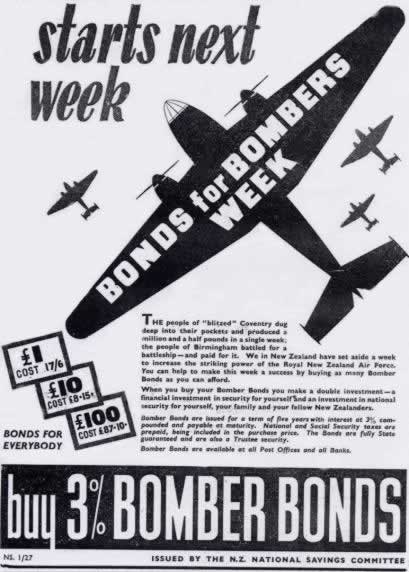
The August 1942 Visit
Not too long after the success of their second visit to Cambridge, the RNZAF Band made a welcome return. Flt Lt Gladstone Hill returned with his full strength band of 60 members while on another tour in aid of Patriotic Funds.
The announcement of their impending return was made in the Waikato Independent on the 7th of August 1942, and further pre-publicity followed to arouse the interest of the town, a large front page advert in the paper on the 14th of August that announced the band would be in Cambridge on the following Thursday, the 20th , and with them would be Ena Rapley, a soprano singer and “leading NZ Radio and Concert Artist”. The advert proclaimed that she was NZ's Gladys Moncrieff. Also appearing with the band would be Ray Trewern, a tenor and “Winner of Governor-General's Gold Medal as Champion Vocalist of Australia for the year 1935.”
According to the write-up these two singers would be “In Solos and Duets from Musical Comedy, with special Band Accompaniments.” The advert went on to hail the show, saying it will be “Something New and Novel, The World's Best In Music.” The event was a little extended upon compared with the visit of March 25th . This time there would be not only the marching display in Victoria Street from 2 till 4pm, but also an evening concert from 8pm in the Town Hall. Admission prices to the latter display were 3/- and 2/-, with children at half price. Tickets could be booked at Cummings, the local bookshop, and it also asked for residents who were willing to provide billets for band members to contact the Town Clerk's office.
Once again the Mayor of Cambridge asked that the shops be shut from 2 till 4pm so everyone could attend the street parade and demonstration on the Thursday afternoon. This time the parade was to include another important part of the town's wartime infrastructure, the Cambridge Home Guard.
On the day after the event a full report in the paper read, “All in aid of Cambridge's share of £6000 in the Dominion's All Purposes Patriotic Appeal the town presented a gay, and at the same time, a real military appearance, yesterday afternoon, on the occasion of the visit of the Royal NZ Air Force Band. With the weather sympathetic, Victoria Street was lined with about 1500 district residents and the hundreds of children enjoyed a spectacular treat, as did the adults.”
“The Air Force Band of 60 strong led by Drum-Major (W.O.) J.H. Hardwick, with the musical conductor, Flight Lieutenant H. Gladstone Hill, in attendance, arrived by special train at 1.30pm. In the meantime the Home Guard, LOC Company and WWSA unit to a total strength of 250 were preparing for the march through the streets. At 2.20pm the parade, headed by the Air Force Band, and commanded by Captain A.J. Swayne, moved off from the Town Hall. In column of route the march was really spectacular, but it was more so, when, after turning at the Drill Hall intersection, it returned in column of platoons. At a point opposite the Bank of NZ the Deputy Mayor, Mr A.H. Nicoll, and Major R.S. Alford (CO of the Home Guard Battalion) took the salute. The crowd appeared pleased with the marching for the band and each company was applauded as they marched past. The Home Guard and other units continued the march to Victoria Square where they were dismissed.”
“While the band was giving an exhibition of ceremonial marching WWSA girls were busy collecting and the response was a generous one. The local travelers, in costume, were also conducting competitions from a lorry.”
The paper reported that the collections and the later concert in the Town Hall had netted £320. The evening show was so popular that people were literally turned away at the door.
During this visit to Cambridge, the Waikato Independent listed all the members and their roles within the RNZAF Band. They are as follows: (some Christian names have been added to the original list where known)
The August 1942 Band Members
Director
Flt Lt H. Gladstone Hill
Deputy Conductor
Flt Sgt Richard H. (Dick) Simpson
Drum Major & Percussionist
W/O Jim H. Hardwick
Clarinetists
LAC F.J. Bulow
LAC K. Harris
LAC M.S. Tonks
LAC M. Combridge
LAC R. McKenzie
LAC E.G. Truscott
LAC T. Dunn
LAC F.J. Redshaw
LAC P.A. Waters
LAC R. Girvan
LAC W. Shardlow
Clarinet, Sax and Dance Band Leader
Cpl Floyd
Bass Clarinet
LAC M. Wishnowsky
Second Principle Clarinet
AC2 K.A. Wilson
Principal Clarinet Soloist
Cpl J. McCore
Cornet Players
LAC R.J. Loper
LAC W.L. Richards
LAC G.P. Salthouse
LAC P.W. Reeves
LAC A.C. Calcott
Sgt H.C.W. Geard
AC1 M.J. Milne
AC2 C.W. Outhwaite
Horn Players
LAC Peter Glen
LAC F. Ormrod
AC1 B.D. Hughes
AC1 H.R. Ormond
Euphonium Players
LAC A.C. Ramsay
Cpl R.W. Willis
AC1 E.A. Bennett
Bass Players
LAC F. Bourke
LAC L.R. Burley
LAC Maurice A. (Mott) Connor
LAC E. Tallantire
AC1 C.R. Tobeck
Trombone Players
LAC R.W. Miller
LAC J.E. Richardson
LAC G.H. Christiensen
LAC E.R. Dry
Cpl G.E. Wells
E Flat Alto Saxophone Players
LAC E.C. Minifie
Sgt E.K. Thurketile
B Flat Alto Saxophone Players
LAC A. Munro
Baritone Saxophone Players
AC1 H. Bale
Flute and Piccolo Player
LAC W.D. Boffa
Oboe Players
Flt Sgt R.H. Simpson
Cpl F.R. Robb
Drum Corps
Cpl A.B. McWhinnie
LAC John S. Love
LAC L. Rycroft
AC1 B.G. Crawford
AC1 E.G. Sturt
AC1 E.B. Sundberg
AC1 H.R. Logan
AC2 Alfred G. (Alf) Craddock
AC2 J. George Jeffries (also vocals)
Drum Corps & Saxophone
LAC J. Griffiths
The RNZAF Band's March 1944 Visit
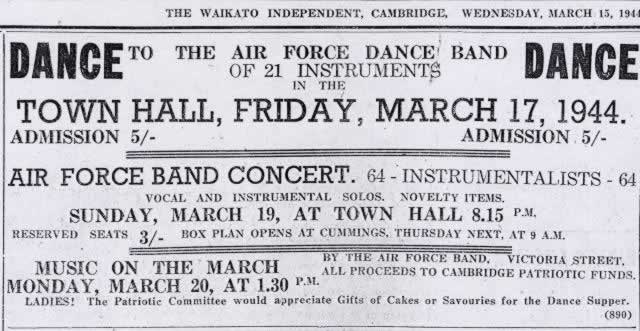
The Royal New Zealand Air Force Band visited Cambridge once more over a weekend in March 1944. Again led by Flight Lieutenant Gladstone Hill, the band made a triumphant return to the town. The band was also visiting Hamilton and this time they were billeted in that city for their stay. But this was the longest trip to Cambridge yet.
First of all, the Air Force Dance Band, a 21 instrument sub-group of the main band, performed at a dance at the Cambridge Town Hall on Friday 17th of March, which the Waikato Independent said “was a great success and there was a large attendance”. The paper reported, “a feature of the evening's programme was a marching display by the Cambridge Physical Culture Club girls led by Miss M. Stuart, and the marching and physical exercises made up an excellent number that was greatly appreciated by the audience.”
The report stated that piper J. Hutchinson played the march, and the display concluded when the girls sang ‘Lords Of The Air'. Ladies of the Patriotic Committee provided a savoury supper, and the Patriotic Secretary, Mr Frank T. Ray, announced during the evening that they had raised £80 in door takings, which would go to the Cambridge Patriotic funds.
The full 64 piece RNZAF Band then performed a concert in the Hall on the evening of Sunday, beginning at 8.15pm. It was reported the concert had a large attendance, and, “the band gave an excellent variety, while several solos were enthusiastically received.”
A report said that at the concert, the “programme was varied with songs, trios and quartets as well as several fine band items.” The report said that the large audience showed their appreciation with “deafening applause which followed every item.”
The paper stated, “A highlight of the programme was the appearance of ‘Professor Schultz' (Cpl. Boffa) who was ‘Guest Conductor,' at the invitation of the Lieutenant, for Brahms ‘Hungarian Dance'.” Corporal Boffa apparently entertained the audience for some time and “very successfully burlesqued the temperamental continental orchestra leader. The Professor's antics were so funny that it was difficult at times to hear the spoken words above the roars of laughter. He is a born comedian, and touches of comedy in the programme detracted from the ‘heaviness' usually associated with band programmes,” the newspaper reported.
Another highlight of the concert was the tenor voice of Bandsman Ray Trewern, who sang a request number, “I'll Walk Beside You” in addition to his programmed songs. There was also a choral number, “The Holy City”, which Ray stood out in as soloist, accompanied by the orchestra. This received a great ovation according to the report.
The RNZAF Band were sat on stage dressed all in blue, with the Drum Corps stood behind in a semi circle, who stood out from the rest by wearing white gauntlets.
The band of course were treated to a welcome speech by the Mayor, Edgar James, who congratulated the efforts of the band and reiterated the fact that they were raising money for the patriotic funds, and that they hoped to meet a targeted quota of £4000. James, who was also the chairman of the Patriotic Committee, announced that a further £60 had been raised during the evening of this concert, additional to the £80 raised on the Friday. This seems very good considering the seat price was three shillings.
The band's leader Gladstone Hill spoke briefly to the audience, and he remarked that this was their 595th performance as a band, having traveled all over the country raising funds. The paper reported, “as regards the appeal for money just mentioned by the Mayor, it was his opinion that the wealth and personal goods and chattels of the audience present, would not be worth much if the enemy came to New Zealand. The people left behind should back the boys who were fighting their battles, to the very limit, by giving freely and unconditionally, so that they could continue their fight for freedom, and that we might walk in safety in the highways and byways of our own fine little country.”
And in the continuation of patriotism, the concert concluded with the playing of the National Anthem (which in those days was God Save The King. This anthem still is one of our two official New Zealand National Anthems by the way.)
On Monday the 20th , beginning at 1:30pm, the band concluded their visit to Cambridge with a marching display in the main street of Cambridge. On the 22 nd of March 44, a full report on the event appeared in the newspaper. The speech made by Flt Lt Hill was certainly meant to be a wake-up call for the people of Cambridge. It is reprinted here:
ON THE MARCH
THE AIR FORCE BAND
FLT-LT HILL'S FORCEFUL APPEAL
Monday was indeed a gala day for Cambridge. The day was brilliantly fine, and residents of the district as well as the school children turned out to watch and to hear the band of the Royal New Zealand Air Force. Before the band was scheduled to march down from the town hall at 1.30 the crowd had gathered on each side of Victoria Street, in readiness to give them a good welcome.
Led by W.O. J.H. Hardwick and the Drum Corps, the band marched from the town hall, down Victoria Street, to the bank corner and back to stand opposite the Bank of New Zealand, where they played the following pieces: “Sempre Fidelus,” “My Regiment,” “Maori Waltzes,” “Anniversary Waltz,” “Sword and Lance,” “White Christmas,” “Waltz Land” and a medley of popular songs.
The Mayor, Mr Edgar James said that the people of Cambridge were very fortunate in not only having a glorious day to witness the marching and to hear the playing of the band, but also to have the privilege of hearing this fine band of the Air Force help start off the Patriotic Committee's quota of £4000. “This money is to help our Boys overseas and it is the hope of the committee that it might be raised by direct giving. I felt sure that the visit of the band will help the committee's effort suite substantially.” Mr James said he wished to say how he appreciated the few remarks made by Flight Lieut. Gladstone Hill at the concert on Sunday evening, and he felt sure that they would not fall on barren ground.
The Best Assurance
Flight Lieut. Gladstone Hill said that we who were assembled in Cambridge on Monday, to listen to the band had a great deal to be thankful for. To be able to stand under the blue sky, and in the sunshine of a fine town like Cambridge and to know that we were free from bombing from enemy aircraft.
Continuing Lieut. Hill said that we had not contributed much towards the day, and the place ourselves. The fact that we could stand in the sunshine and enjoy the day was that someone else was fighting our battles “over there”. Someone was giving his life, that we might walk in freedom and safety. He appealed to the people as follows: “You business people, you insure your premises, don't you? You pay the premiums, and the insurance company takes the risk. Well you should, one and all pay the premiums for the Boys Overseas. They are taking the risks. They are going without things they need. We, none of us, know what it is, in this country to go without a meal, or clothing when we need it, yet our boys are suffering untold privations overseas, that we might be free. The least we can do is to give, and give until it hurts. This is the 596th public appearance of the band and it has traveled from one end of New Zealand to the other, to help raise Patriotic Funds, but we feel that even this is a very small thing to do for our brothers overseas. I cannot understand people accepting every day things and not thinking of these boys, and it is a disgrace to New Zealand if they turn down a Patriotic appeal.
I think also that it is rather a disgrace that the Mayor of a town or a city has to come out and plead for money to buy amenities that we are certainly not going without here.”
At this stage, the Lieutenant gave a £1 note to the Mayor and challenged 50 others to do likewise. A short while afterwards he was able to announce that over £60 had been handed in. He further announced that the band was also present for the purpose of recruiting boys for Air Crew and the A.T.C. Replacements were needed for overseas service, and it was hoped to gain many recruits before the day was ended.
Members of the Women's War Service Auxiliary, accompanied by Bandsmen Burke, then went through the crowd to collect coins thrown into a large Union Jack which the girls carried. The total amount collected during the day was about £793 and with promises totaling £250 still to come. Flight Lieutenant Gladstone Hill and members of his Band were later entertained to afternoon tea at the Patriotic tea rooms.
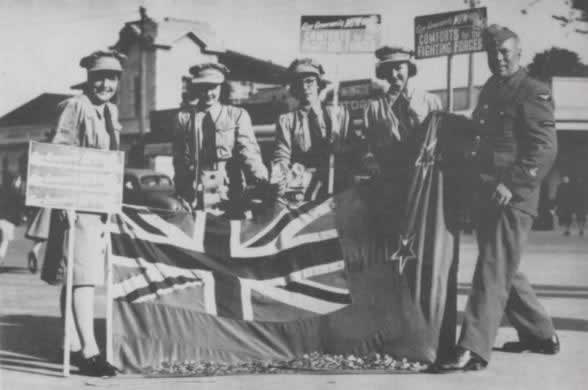
WWSA girls and an RNZAF Bandsmen collecting money on the day. They are, from left to right:
Margaret Nicholson of Pukeroro, Joan Morris (now Joan Epps), Betty Mitchell (later Betty Jones),
Daphne Foote of Hautapu/Fencourt district, and LAC Bourke from the RNZAF Band
The More Detailed Bonds For Bombers Advertisements From the New Zealand Observer issue dated 25th of March 1942

This one features a Lockheed Hudson, one of the bomber types that the bonds would pay for
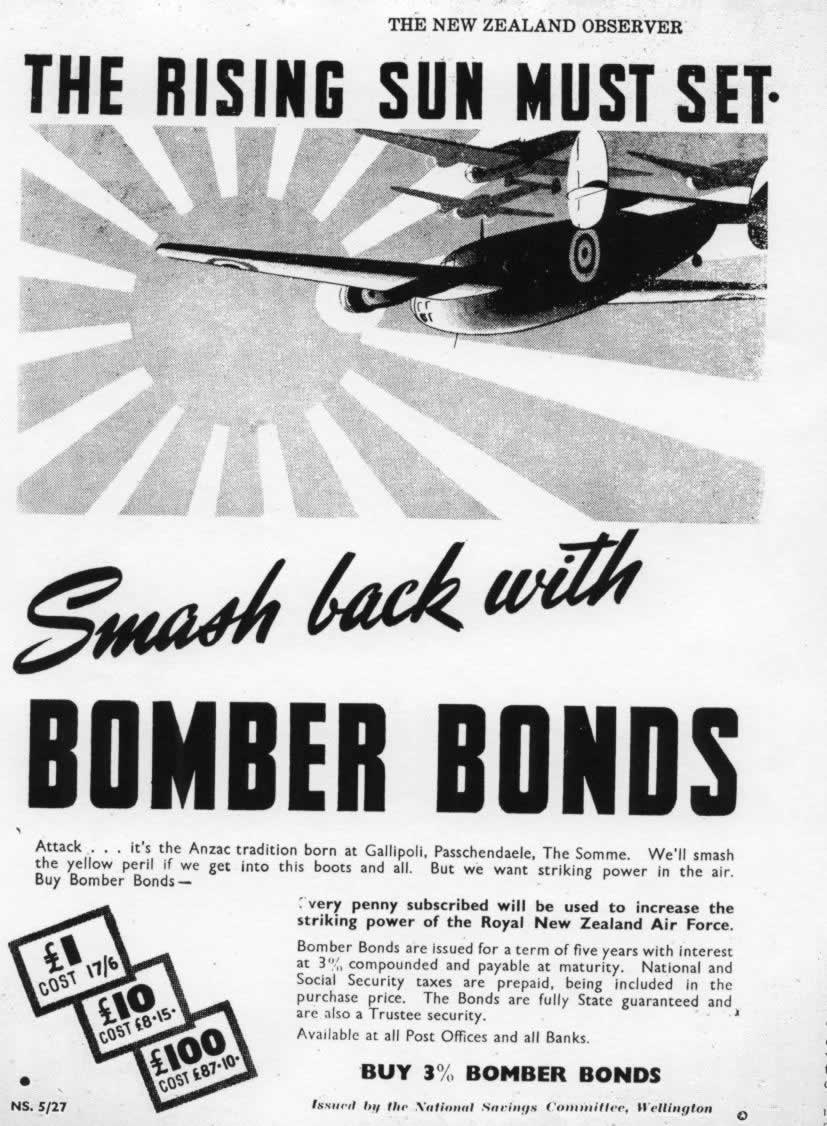
See a review of the recent concert of the Central Band of the RNZAF at Te Awamutu HERE

